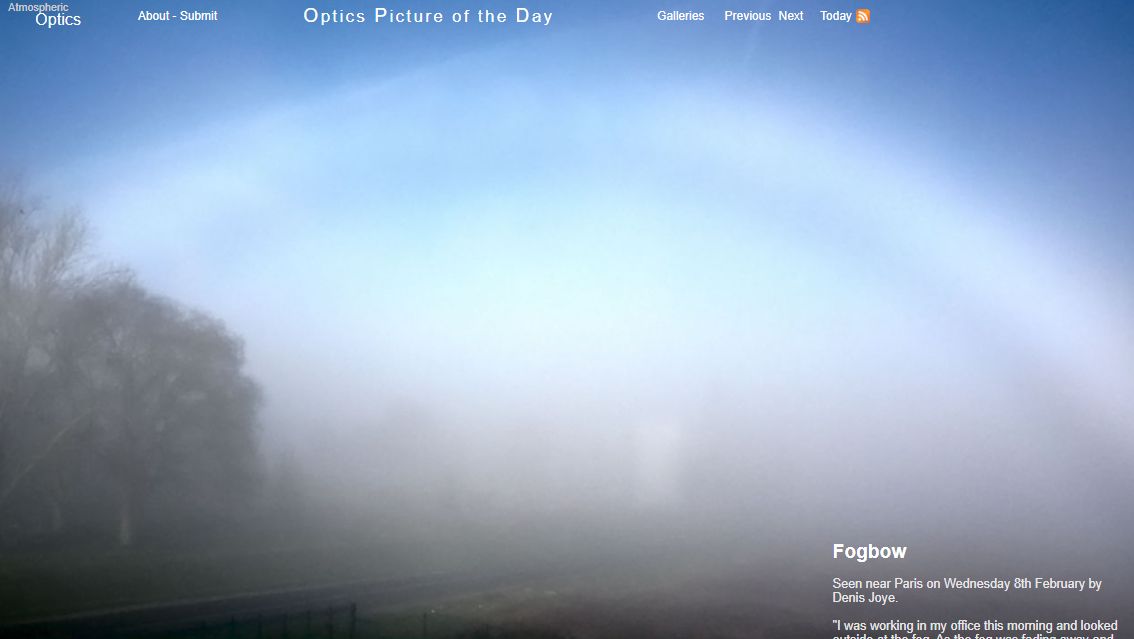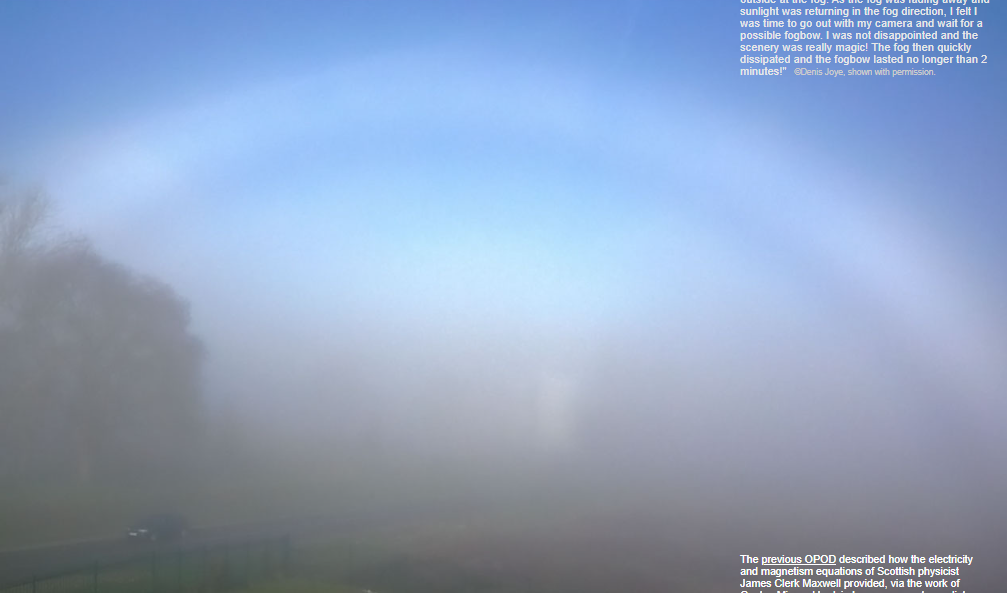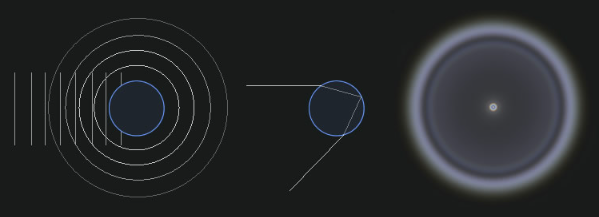OPOD - Wednesday's Fogbow
OPOD - Wednesday's Fogbow: A Magical Phenomenon Revealed
Have you ever witnessed a breathtaking natural spectacle that seemed almost magical? Denis Joye, an observer near Paris, captured such a moment on Wednesday, February 8th. As he looked out of his office window, he noticed the fog dissipating and the sunlight breaking through. Sensing the perfect opportunity, Denis grabbed his camera and ventured outside, hoping to witness a rare phenomenon known as a fogbow. And he was not disappointed! The scene before him was truly enchanting, as a delicate fogbow appeared and lingered for a mere two minutes.
The Science Behind Fogbows
Fogbows, like rainbows, are optical phenomena that occur when light interacts with tiny water droplets suspended in the air. However, there are some key differences between the two. While rainbows form when sunlight refracts, reflects, and disperses within raindrops, fogbows are created by the diffraction of light waves by small fog droplets. This diffraction causes the light to scatter and form a diffuse bow, often with pale colors.
To understand fogbow formation more comprehensively, we can turn to the groundbreaking work of Scottish physicist James Clerk Maxwell. His equations on electricity and magnetism, further developed by Gustav Mie and Ludvig Lorenz, not only explain the colored rings seen opposite the sun during foggy conditions but also account for various optical processes such as reflections, refractions, and diffractions.
Interestingly, the physics behind fogbows can be imagined using a simpler model than that of rainbows. As light waves enter the small fog droplets, some are internally reflected from the opposite side before emerging at different angles. This deflection of light, combined with diffraction caused by the small droplets, leads to the formation of a fogbow. Unlike rainbows, fogbows lack the vibrant colors and distinct bands due to the diffracted light being less intense. Instead, they exhibit a more diffuse and ethereal appearance.
Exploring the Features of Denis Joye's Fogbow
Denis Joye's captivating fogbow, as imitated by an IRIS calculation, provides valuable insights into the unique characteristics of this atmospheric phenomenon. The calculation reveals a dark band positioned just inside the primary bow. This dark band arises from the variation in droplet sizes, with a standard deviation of 20%. The blurring effect caused by this variation in droplet sizes further contributes to the faint and delicate nature of the fogbow, resulting in the pale colors and indistinct supernumeraries observed.
The Ephemeral Nature of Fogbows
Fogbows, much like their ethereal appearance, are transient in nature. They tend to form and dissipate relatively quickly, often lasting no longer than a few minutes. The rapid disappearance of fogbows can be attributed to the dispersion and evaporation of fog droplets as the fog itself dissipates. Thus, capturing a fogbow on camera is truly a remarkable feat, as it requires perfect timing and a keen eye for atmospheric conditions.
Further Insights into Atmospheric Optics
If you find yourself fascinated by atmospheric optics and the wonders it presents, you may be interested in exploring the original article that inspired this blog post. While this article has been automatically converted from its previous format, it still provides valuable information on fogbows and other optical phenomena. Delve into the world of atmospheric optics and uncover the intricacies of these captivating natural spectacles.
Conclusion
Denis Joye's encounter with a fogbow near Paris serves as a testament to the awe-inspiring beauty of atmospheric optics. Through the interplay of sunlight and tiny fog droplets, a mesmerizing phenomenon unfolded before his eyes. Fogbows, created through diffraction and deflection of light waves, exhibit a delicate and ethereal appearance. With their pale colors and fleeting nature, fogbows remind us of the transient wonders that can be found in the world around us. So, keep your eyes open and your camera ready, for you never know when the magic of atmospheric optics may reveal itself to you.

Fogbow
Seen near Paris on Wednesday 8th February by Denis Joye.
"I was working in my office this morning and looked outside at the fog. As the fog was fading away and sunlight was returning in the fog direction, I felt I was time to go out with my camera and wait for a possible fogbow. I was not disappointed and the scenery was really magic! The fog then quickly dissipated and the fogbow lasted no longer than 2 minutes!" ©Denis Joye, shown with permission.

The previous OPOD described how the electricity and magnetism equations of Scottish physicist James Clerk Maxwell provided, via the work of Gustav Mie and Ludvig Lorenz, a way to predict exactly the coloured rings seen opposite the sun when it starts to shine through a fog.
The theory does more. It automatically takes account of all the optical processes, reflections, refraction and diffraction. It simultaneously predicts the fogbow often seen outside a glory.
Unlike the glory, fogbow formation can be imagined using a simpler physical model. Light waves enter the small fog droplets, some are internally reflected from the opposite side and they then emerge strongly deflected. The process is identical to the formation of a rainbow except that the light waves are significantly diffracted by the small droplet. The result is a diffuse bow with, at most, pale colours.
The IRIS calculation at left imitates Denis Joye's bow with a dark band just inside the primary bow. To do this the droplets were given a 20% (std.dev.) variation in sizes to blur the supernumeraries. Old fog has a wide distribution of droplet sizes!

Note: this article has been automatically converted from the old site and may not appear as intended. You can find the original article here.
Reference Atmospheric Optics
If you use any of the definitions, information, or data presented on Atmospheric Optics, please copy the link or reference below to properly credit us as the reference source. Thank you!
-
<a href="https://atoptics.co.uk/blog/opod-wednesdays-fogbow/">OPOD - Wednesday's Fogbow</a>
-
"OPOD - Wednesday's Fogbow". Atmospheric Optics. Accessed on November 26, 2024. https://atoptics.co.uk/blog/opod-wednesdays-fogbow/.
-
"OPOD - Wednesday's Fogbow". Atmospheric Optics, https://atoptics.co.uk/blog/opod-wednesdays-fogbow/. Accessed 26 November, 2024
-
OPOD - Wednesday's Fogbow. Atmospheric Optics. Retrieved from https://atoptics.co.uk/blog/opod-wednesdays-fogbow/.